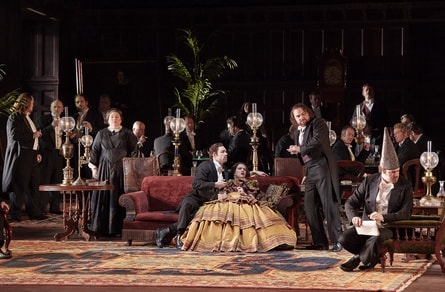 A scene from the COC's 2018 Rigoletto. Photo: Michael Cooper.
A scene from the COC's 2018 Rigoletto. Photo: Michael Cooper. Tenor Stephen Costello was scheduled to sing the role. Then, at the opening of Act II, it was announced that he was in poor health but would carry on. However, in Act III he did not reappear, but tenor Joshua Guerrero (scheduled to sing the role at the COC from Feb. 11-23) stepped in. Although it was Costello who did most of the heavy lifting on Saturday, it was Guerrero who took the final bow.
In Act III, Guerrero offered a taste of the kind of Duke he’ll be when he takes over the role in February. His voice is brighter than Costello’s and he’s more flexible dramatically; his “La donna è mobile” was surprising, vocally speaking, with abrupt glottal stops and even a touch of falsetto. It was unorthodox but impressive.
Opposite the Duke(s), as Gilda, was soprano Anna Christy – and a better-suited singer would be hard to find. Her lovely voice was youthful yet sophisticated, fragile yet fulsome, and as sweet and fluid as honey. And in the title role, baritone Roland Wood is a superb singing-actor. Indeed, he never “just sings” anything: every note and every phrase that came out of his mouth was bursting with dramatic purpose. It was not always beautiful, but it was always compelling.
As for the “production itself” – the sets, costumes and staging – I’ll begin by saying that I am always pleased by the intricate and subtle attention to detail that designer Michael Levine brings to his work. Every tableau he creates is like a Vermeer painting. But on this occasion, I can’t help suspecting that he misread the memo, and created a brilliant design for La Traviata instead of Rigoletto. Yes, I know the clichés – Renaissance settings and a jester’s outfit for Rigoletto – have been done to death a thousand times. And yes, I know that the idea was to make this Rigoletto a commentary on the mores of the mid-19th century, when Verdi wrote it (and perhaps on our own times, as well). But for all its grandeur, this single-piece set is just confusing.
And I wouldn’t say that director Christopher Alden did much to clarify the situation. His handling of the cast is willful and stagey. (I can imagine the singers, as they went through their paces, thinking, “Why am I doing this?”) And the pregnant pauses between Acts – nothing but a black curtain, with a few cast-members acting out an awkward pantomime to kill time – are a real drag on the production.
So there we have it: a vocally glorious but theatrically problematic Rigoletto from the COC.
© Colin Eatock 2018
 RSS Feed
RSS Feed

